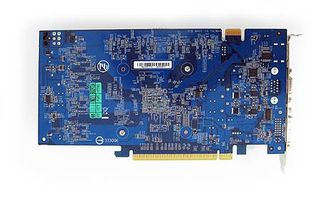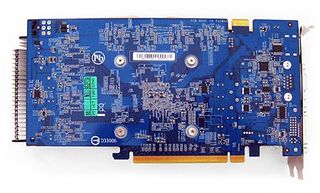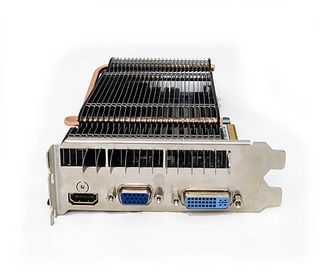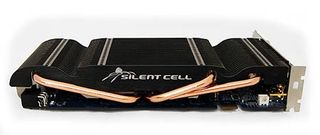GeForce 9600 GT/GTS 250/GTX 260 Non-Reference Roundup
Gigabyte’s GV-N96TSL-1GI And GV-N96TZL-1GI: Identical PCBs And Overclocking


These cards are both based on the same non-reference GeForce 9600 GT board unique to Gigabyte. At 8.5" long, the cards are a bit shorter than the reference 9600 GT, but they pack Gigabyte’s Ultra Durable VGA feature, which includes 2 oz. of copper on the PCB, Samsung or Hynix memory, Japanese solid capacitors, ferrite core chokes, and Low RDS (on) MOSFETs. Gigabyte claims that Ultra Durable VGA offers a 5% to 10% lower GPU temperature, a 10% to 30% increase in overclocking capability, and a 10% to 30% reduction in power-switching loss compared to Nvidia’s reference model. If they turn out to be accurate, then we expect some cool temperatures and nice overclocks.


Both of these cards have HDMI, VGA, and dual-link DVI outputs. Without two dual-link DVI outputs, though, these cards can’t run a pair of 30” 2650x1600 monitors at the same time. As with most cards, only two of the three video outputs can be used at the same time.


Neither of Gigabyte’s 9600 GT cards has memory heat sinks, but since the usefulness of memory heat sinks has always been questionable, we don't consider that a significant limitation. Speaking of memory, both cards come with 1 GB, which is twice what a garden-variety GeForce 9600 GT sports.
To provide auxiliary power to the card, these Gigabyte GeForce 9600 GT models require a six-pin PCIe connector, which is par for the course.
Overclocking the Gigabyte GeForce 9600 GT cards
Gigabyte offers a simple utility that it calls the "Gamer HUD."

The Gamer HUD has only three adjustable settings: GPU speed, shader speed, and memory clock speeds. There are also handy temperature- and GPU-usage readouts.
Stay on the Cutting Edge
Join the experts who read Tom's Hardware for the inside track on enthusiast PC tech news — and have for over 25 years. We'll send breaking news and in-depth reviews of CPUs, GPUs, AI, maker hardware and more straight to your inbox.
Using this utility, we managed to get the GV-N96SL-1GI overclocked to 815 MHz on the GPU, 1,810 MHz on the shaders, and 950 MHz (1,900 MHz DDR) on the memory. This is a respectable overclock, considering that this card has no active cooling fan.
As for the GV-N96ZL-1GI, we managed to up the ante a little, but not by much. Our final stable overclock was 820 MHz on the GPU, 1,820 MHz on the shaders, and 1,010 MHz (2,020 MHz DDR) on the memory. Essentially, the GPU/shader overclock was identical to that of the GV-N96SL-1GI, while the GV-N96ZL-1GI had more agreeable memory.
Current page: Gigabyte’s GV-N96TSL-1GI And GV-N96TZL-1GI: Identical PCBs And Overclocking
Prev Page Gigabyte’s GV-N96TSL-1GI And GV-N96TZL-1GI: Different Personalities Next Page Asus ENGTS250 Dark Knight 1G-
Mottamort I was rather disappointed with this article. Not the article itself but with the slightly misleading Title/Intro. When clicking the article I thought I was going to find a massive battle between these vendors on different tiers, instead you show us different instances of 2 slightly different cards of the same type from one vendor....if that makes senseReply
I mean you have Gigabyte vs Gigabyte in the 9600gt section, Asus vs Asus in the 250 section and so on.
:-/ -
dragonsprayer Great articleReply
i wish it had more cards, i think you need 4 parts, try some back cards like the 4870x2 darkknight? good stuff as always!
thx! -
crisisavatar wow how is the gts 250 performing so close to the gtx 260 wasn't the gtx 260 20% faster ?Reply -
enterco It's not clear to me why are you comparing '3dmark score' when you should post 'GPU score'.... It's a graphics card comparision, not platform comparision.Reply -
randomizer entercoIt's not clear to me why are you comparing '3dmark score' when you should post 'GPU score'.... It's a graphics card comparision, not platform comparision.Nothing but the cards is changed so you're not comparing platforms.Reply -
acasel We cannot see clearly the bang for the buck card there if we ain't seeing some ati cards like the 4770 and others..Reply
The drop down menu sure is fast... :-) -
enterco randomizerNothing but the cards is changed so you're not comparing platforms.Sure. A reason more to show GPU score. 3dmark score is too much influenced by CPU's power, and it's no longer relevant, the way it used to be once...Reply
By using a Quad Core and a low-performing GPU you can achive same 3dmark score as using a dual core combined with a considerably stronger GPU, 3dmark Vantage gives too much credit to CPU. But the overall FPS in games it's often higher in the second case: dual core + better GPU. -
marraco Recent review showed the 260 being neck to neck with the 4870; both in price and performance, those cards are in the same point.Reply
Since my 8800GT should be between the 9600 and the 250, I guess that the best upgrade path is to buy a second 8800GT, reaching probably 260/4870 performance.
I searched the web for 8800GT SLI benckmark running in i7 920, but got no one single review...
I think that tomshardware should review non up-to-date cards as the 8800 and the ATI equivalents, in crossfilre/SLI, since for many users, it should make sense to buy a second card that to upgrade to a 260/4870.
older reviews on those cards does not accounted for the scalability on I7 x58 platform, and probably ATI and Nvidia dedicated more time tweaking drivers for newer cards, so maybe the 8800GT does not perform well today (the SLI on core 2/Quad did not worked very well in the past)
Most Popular

